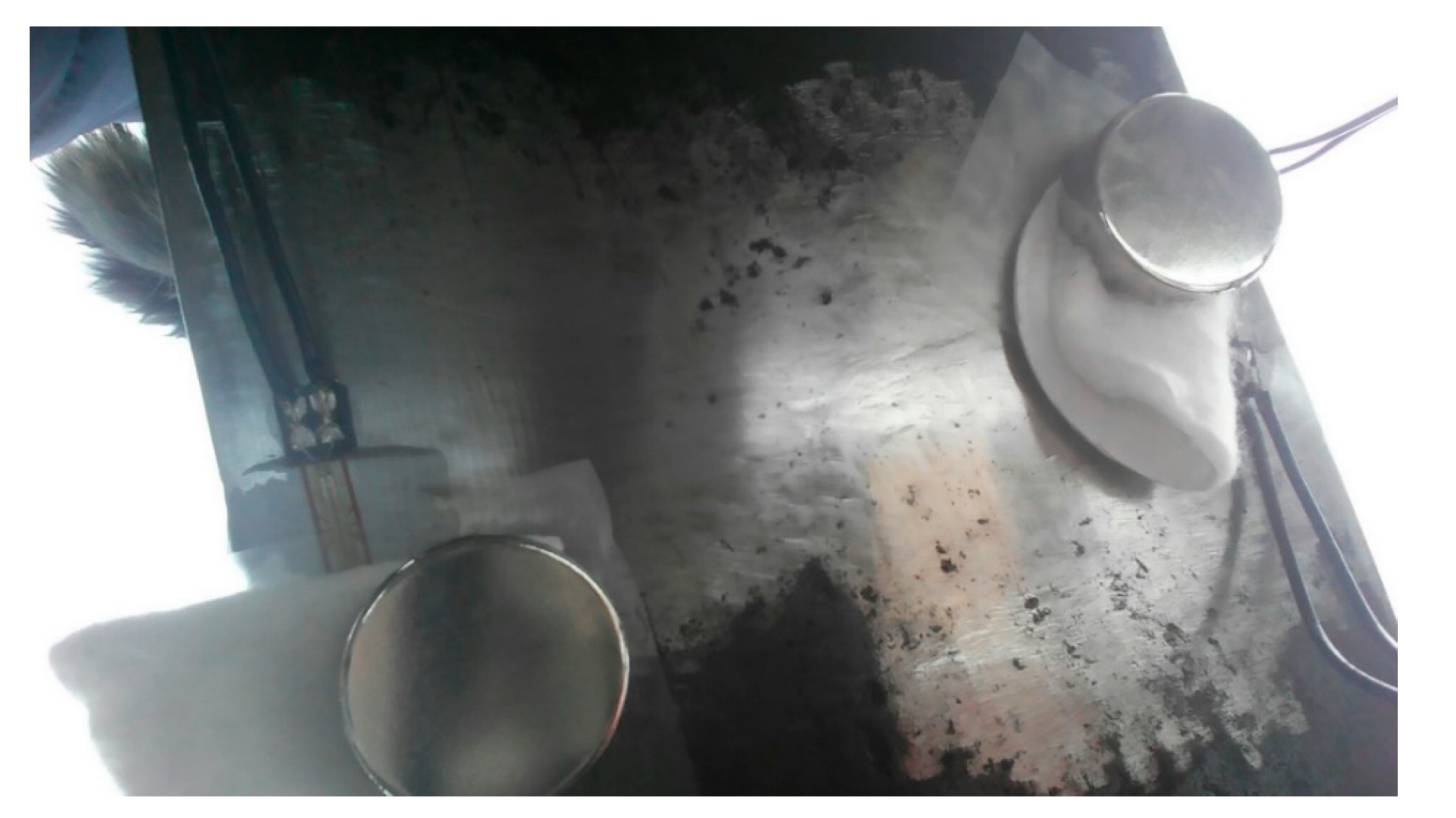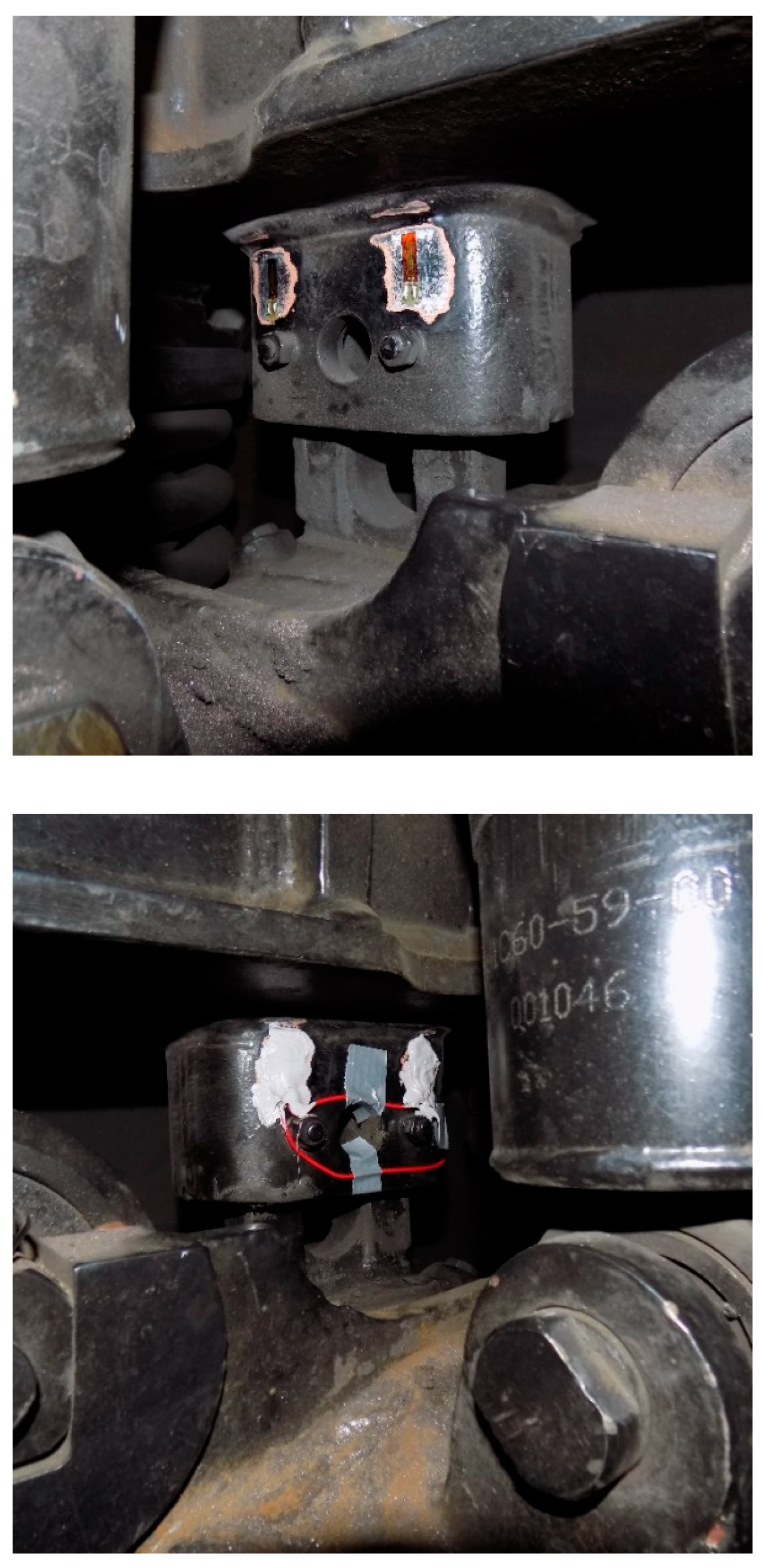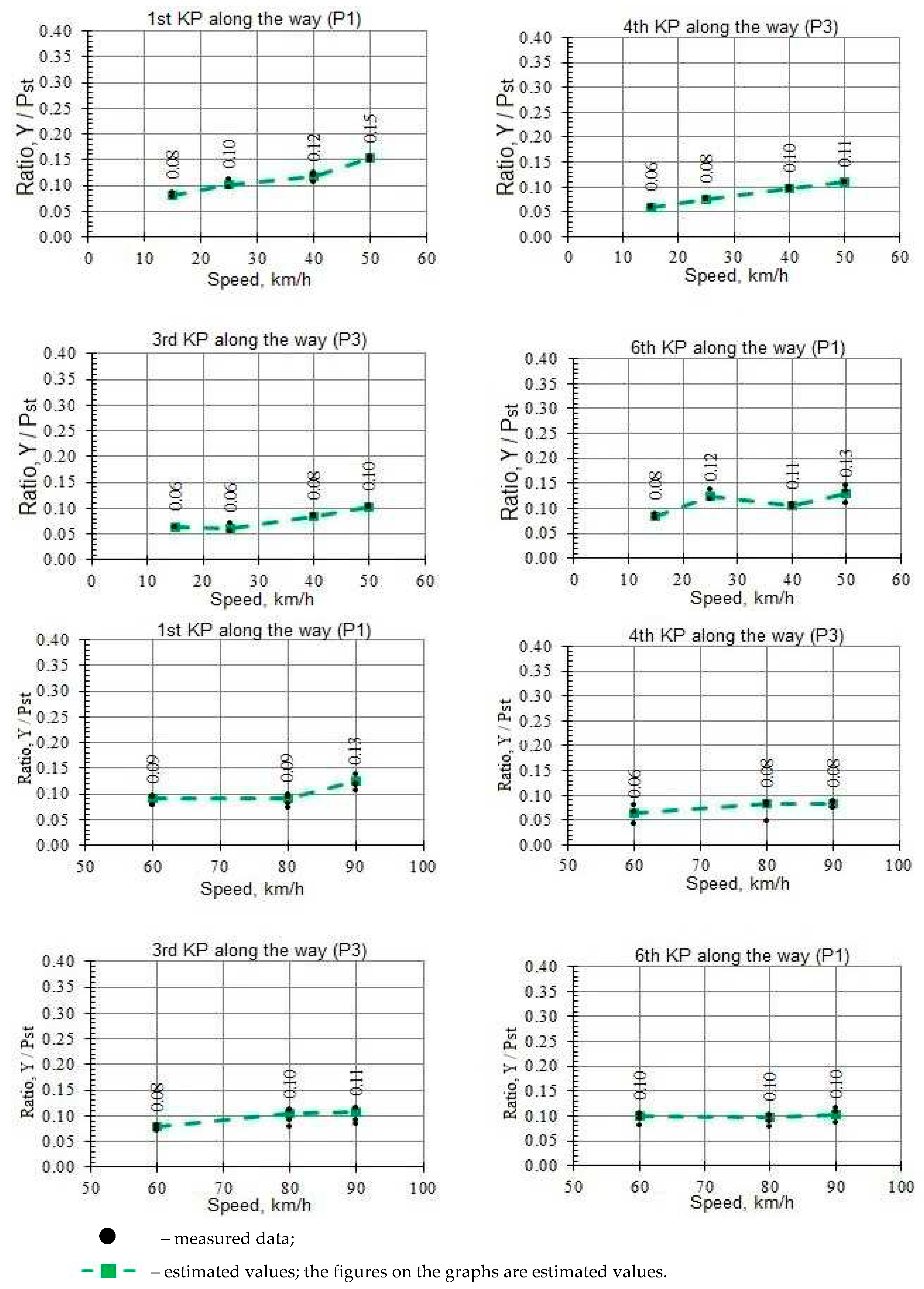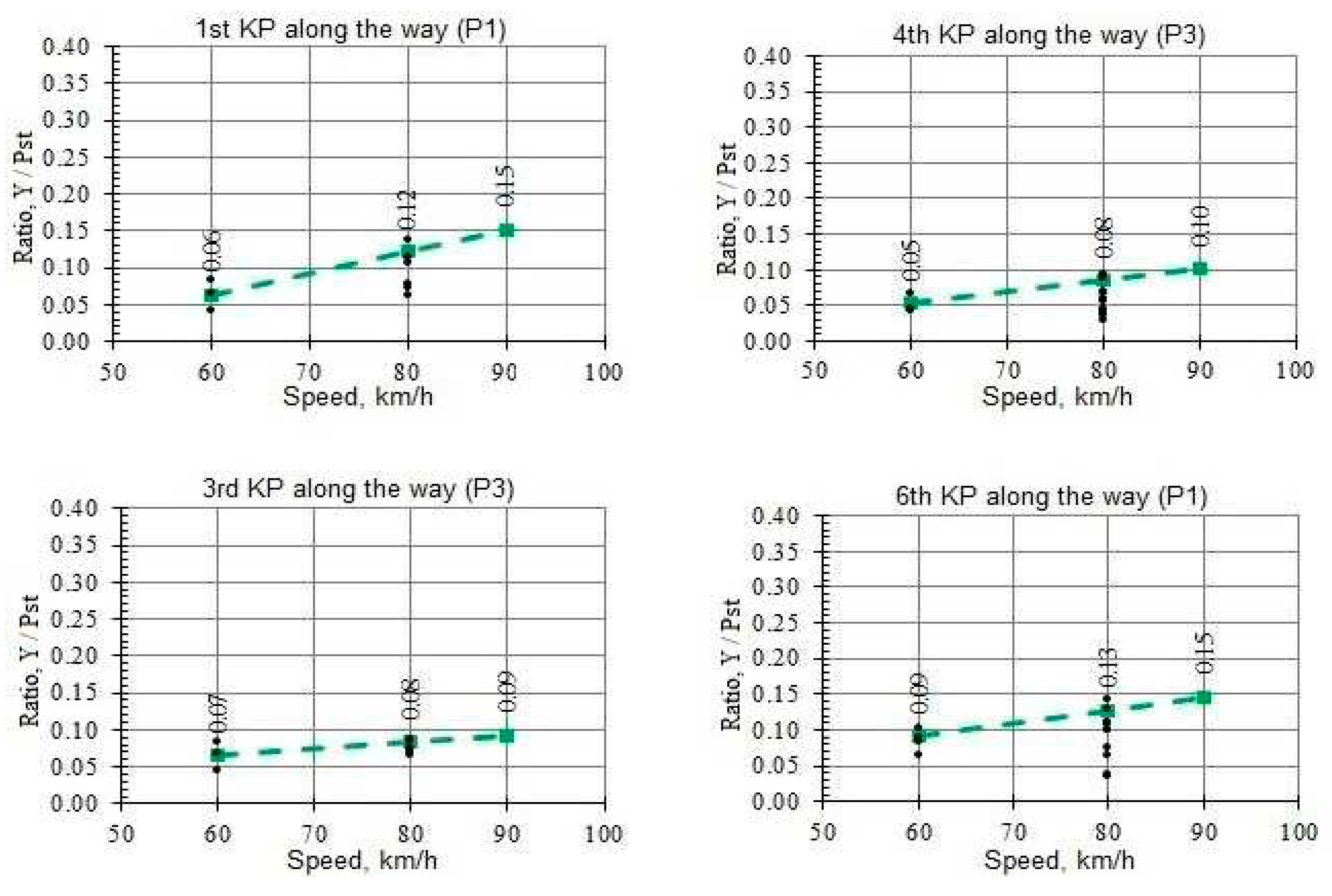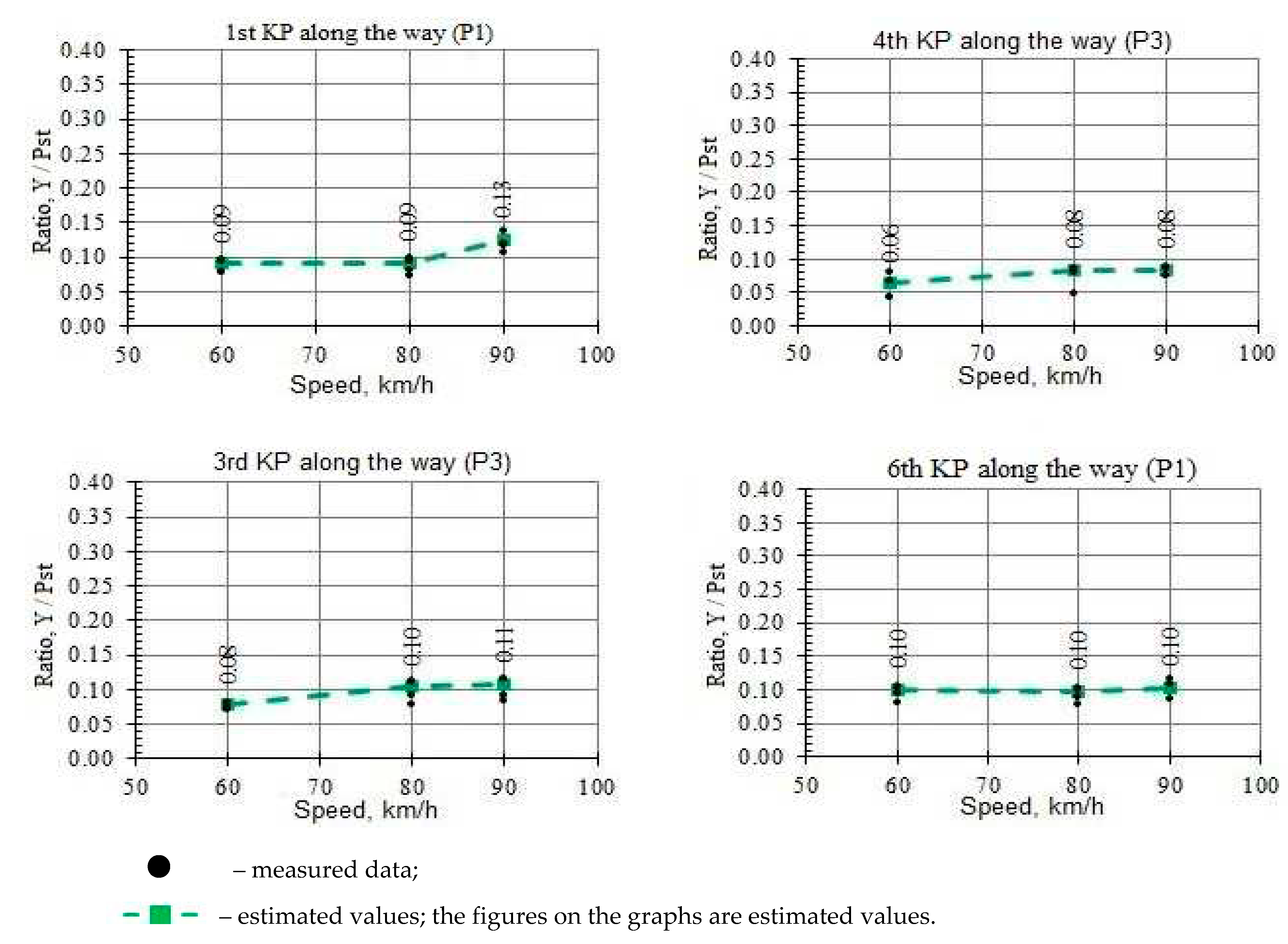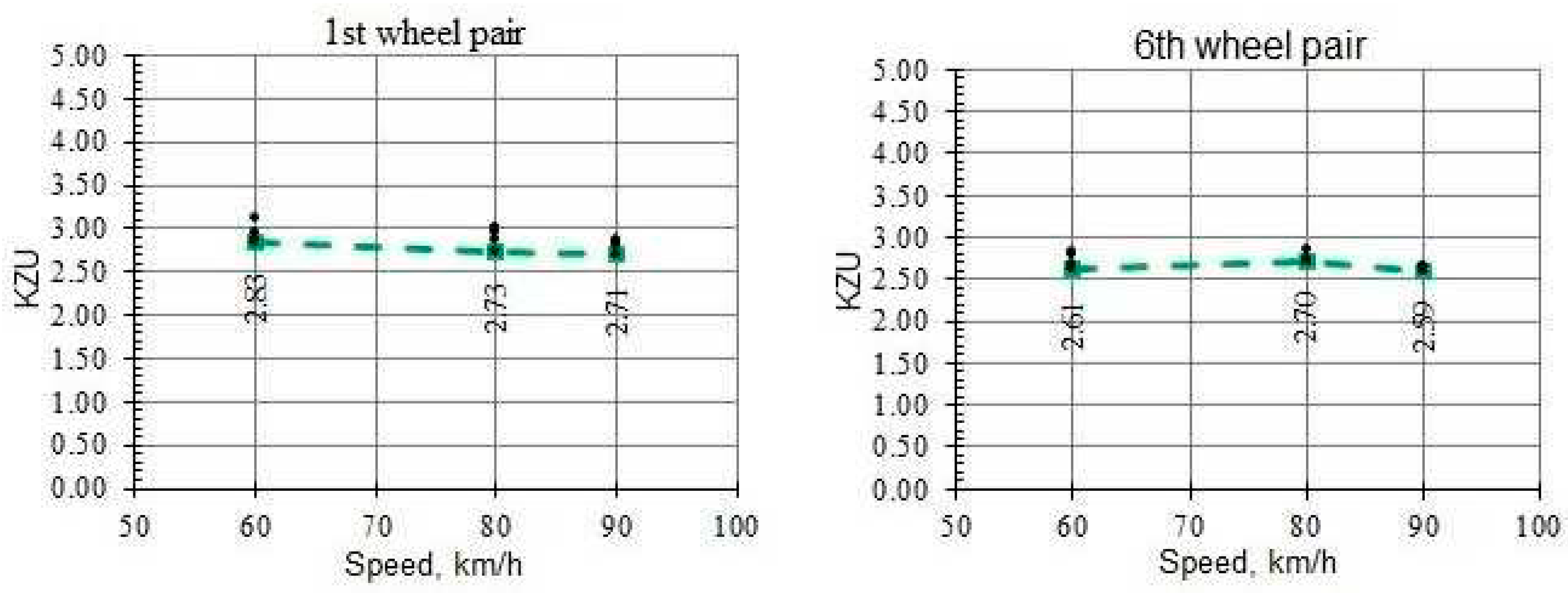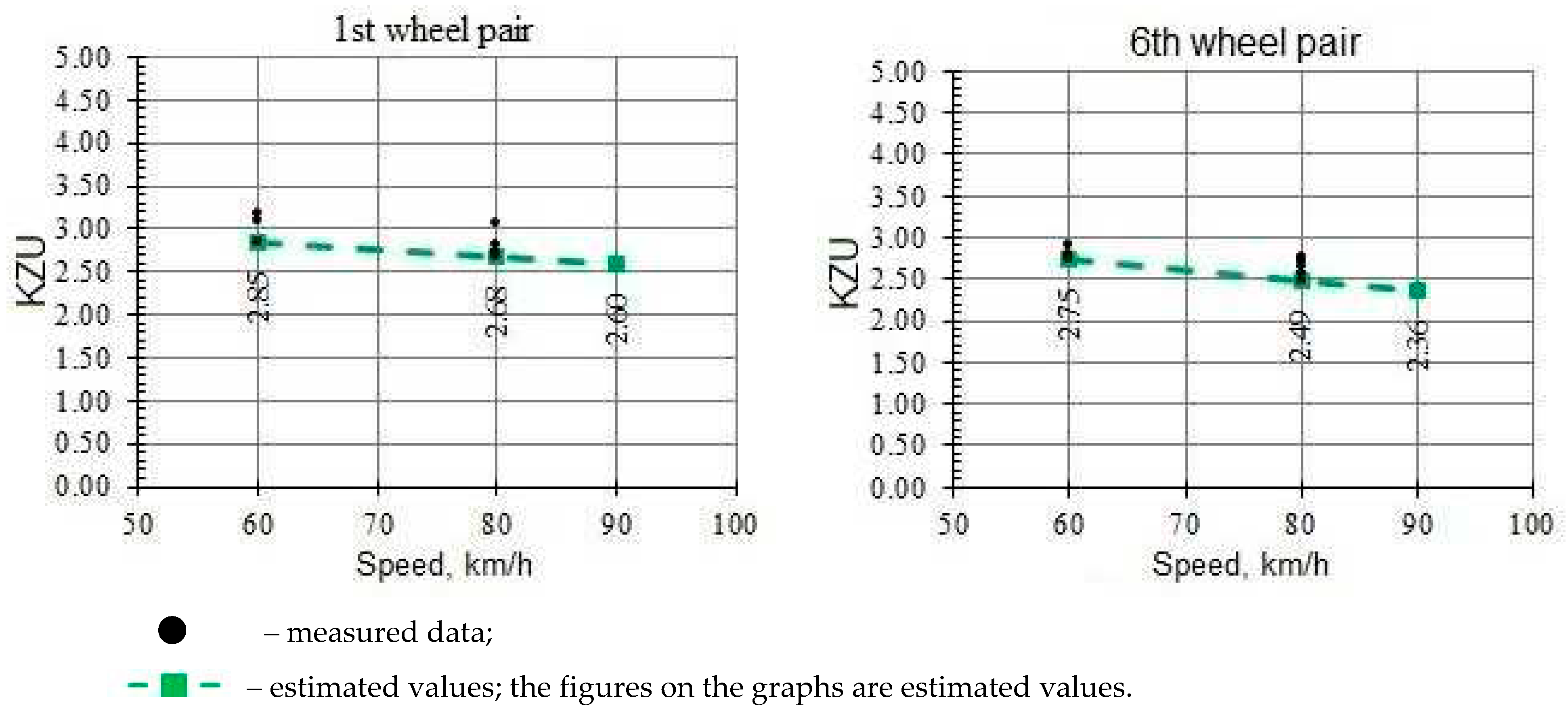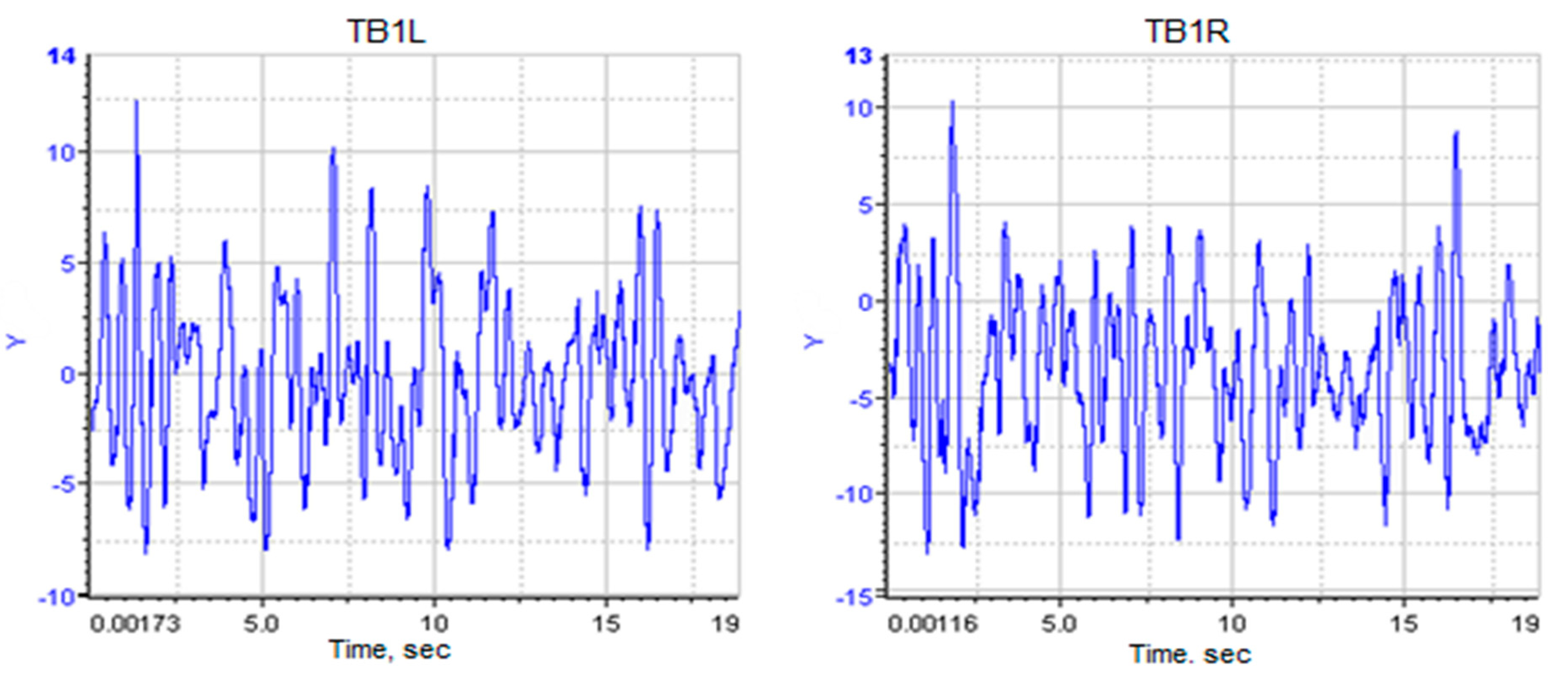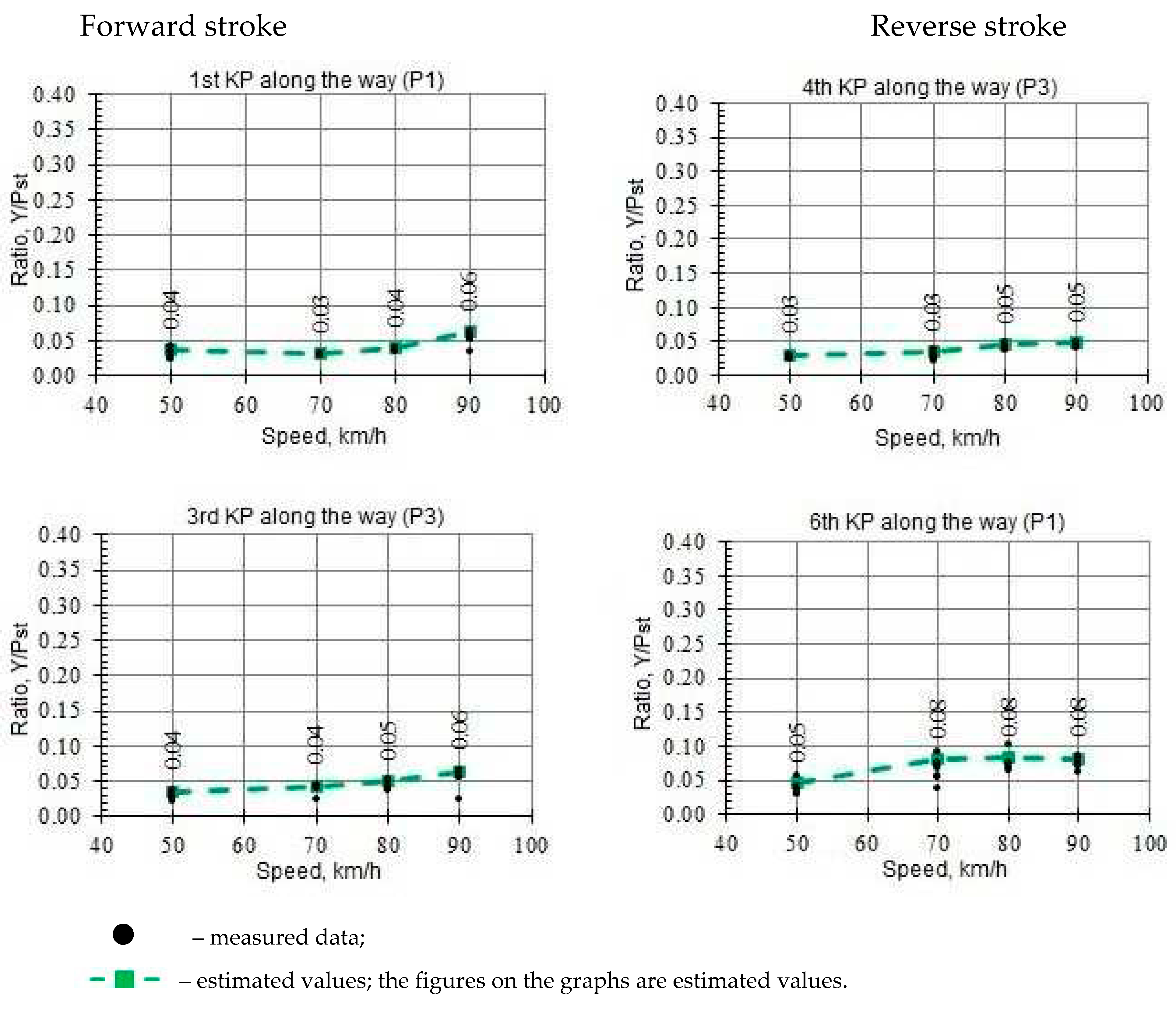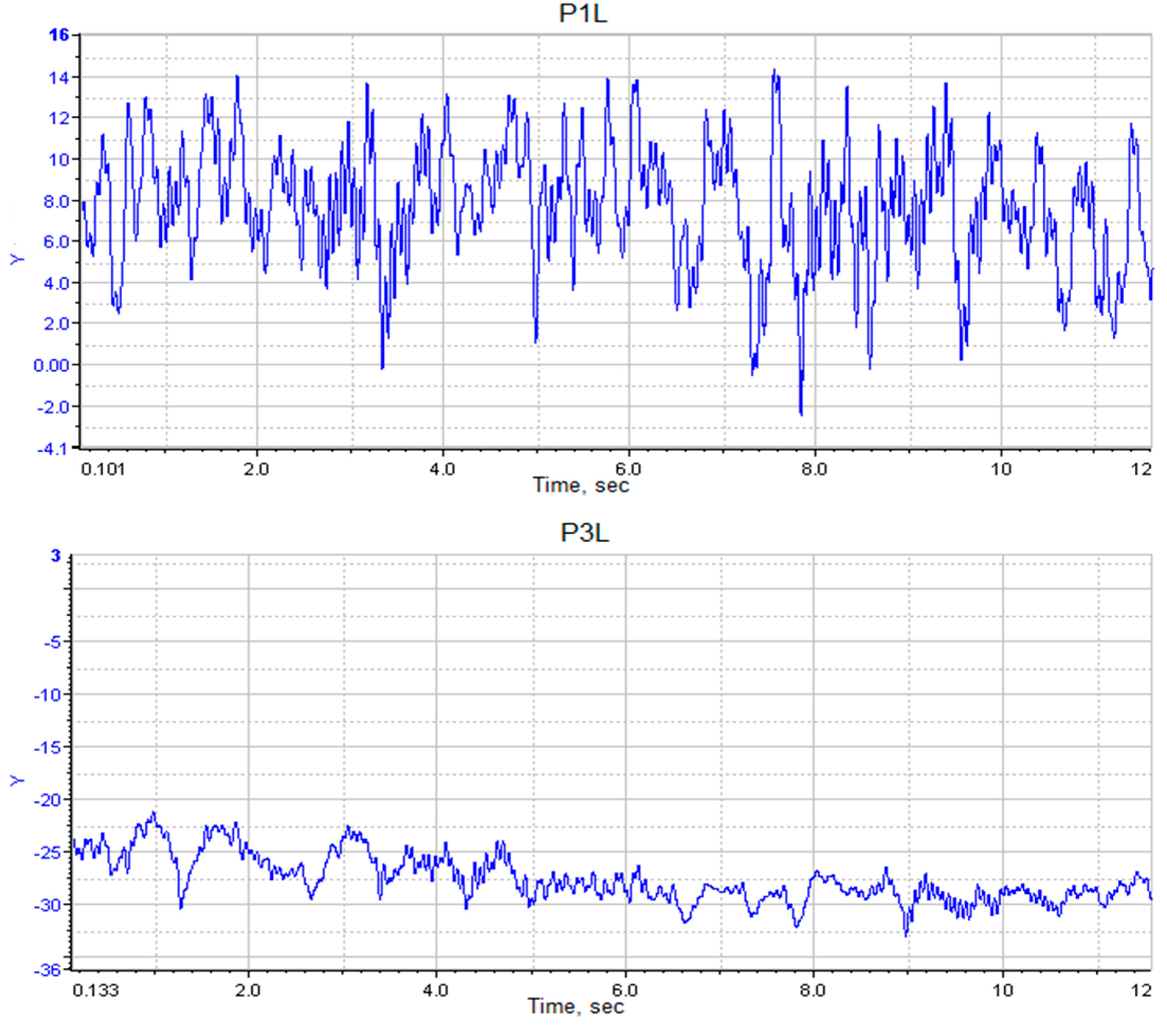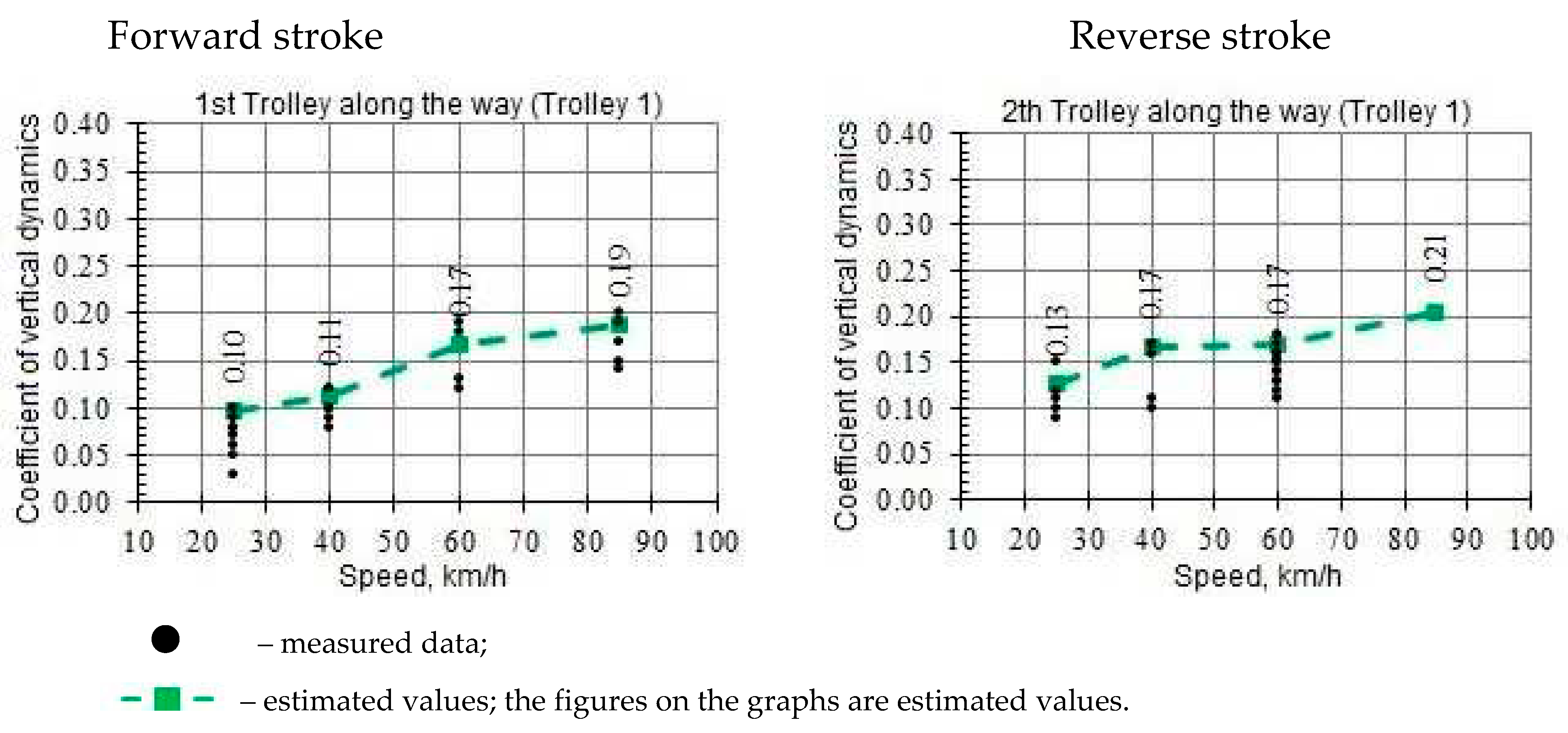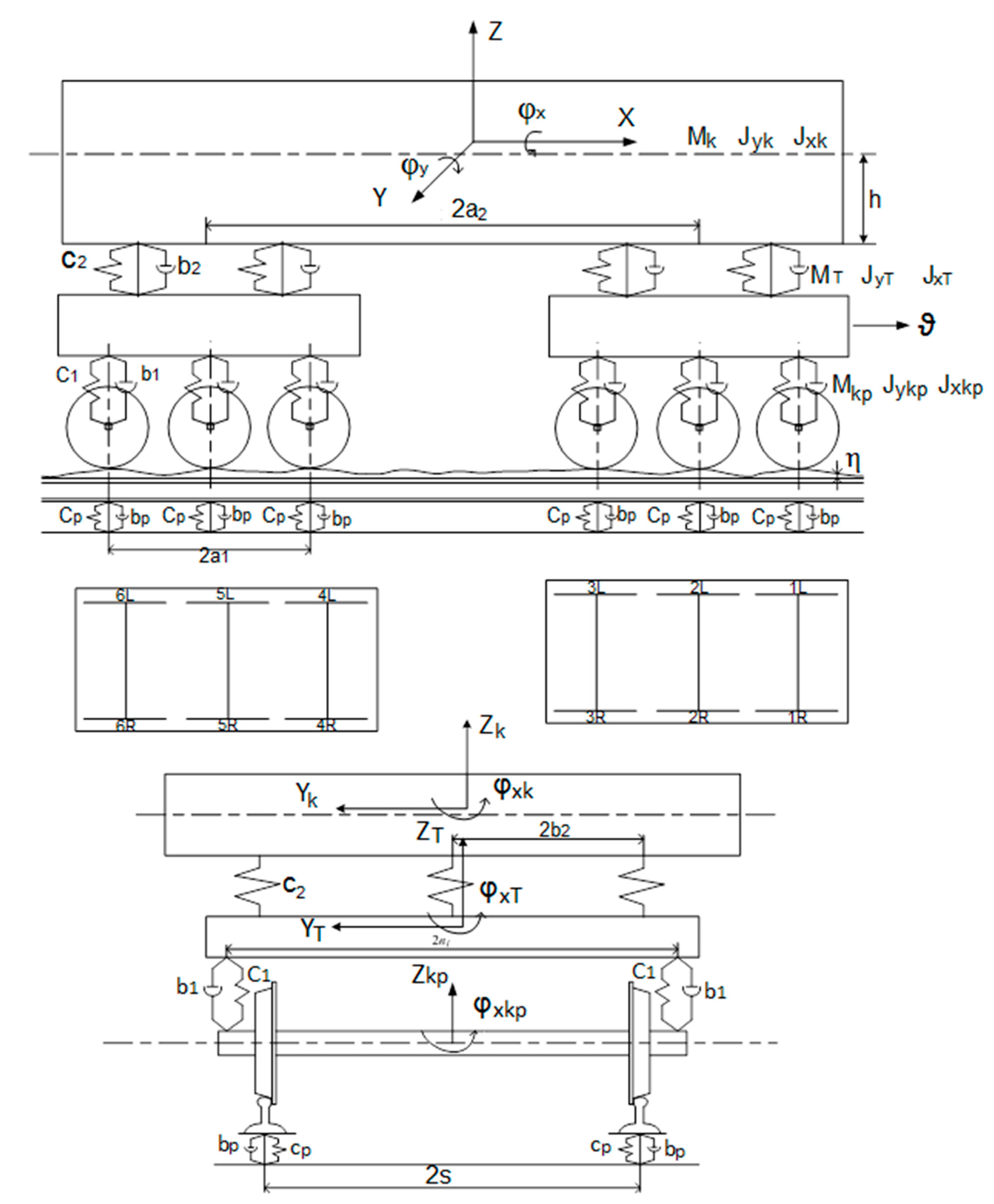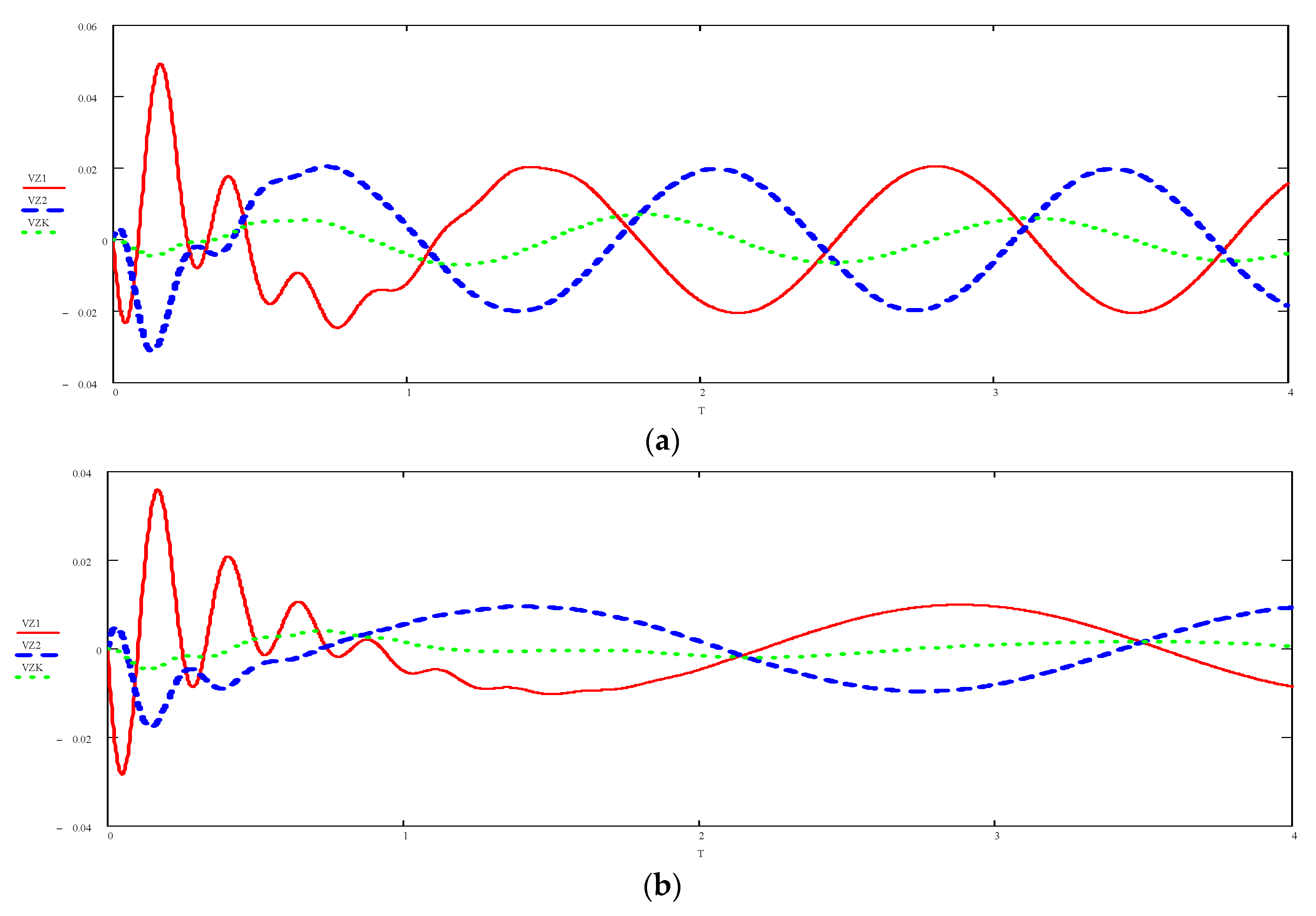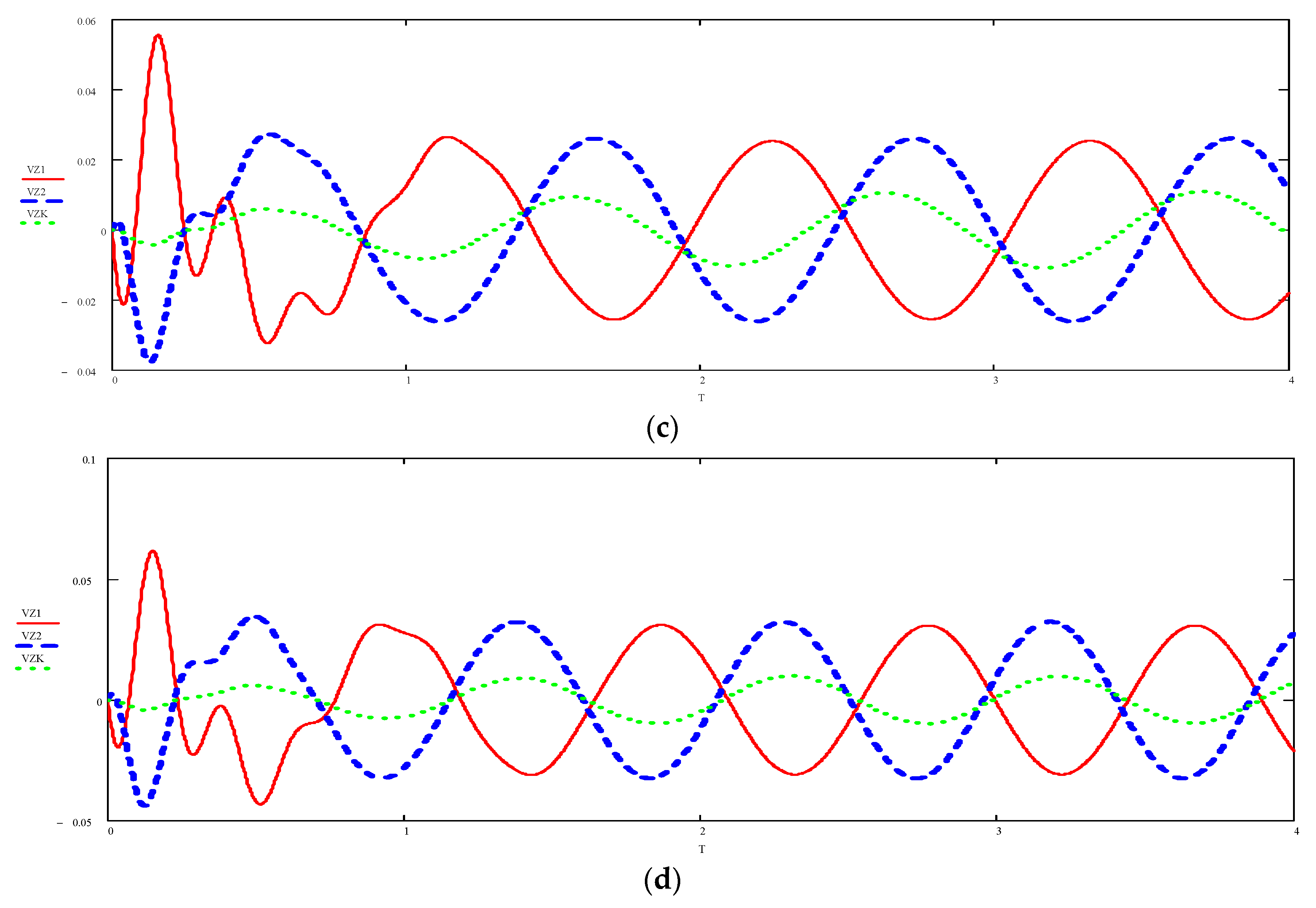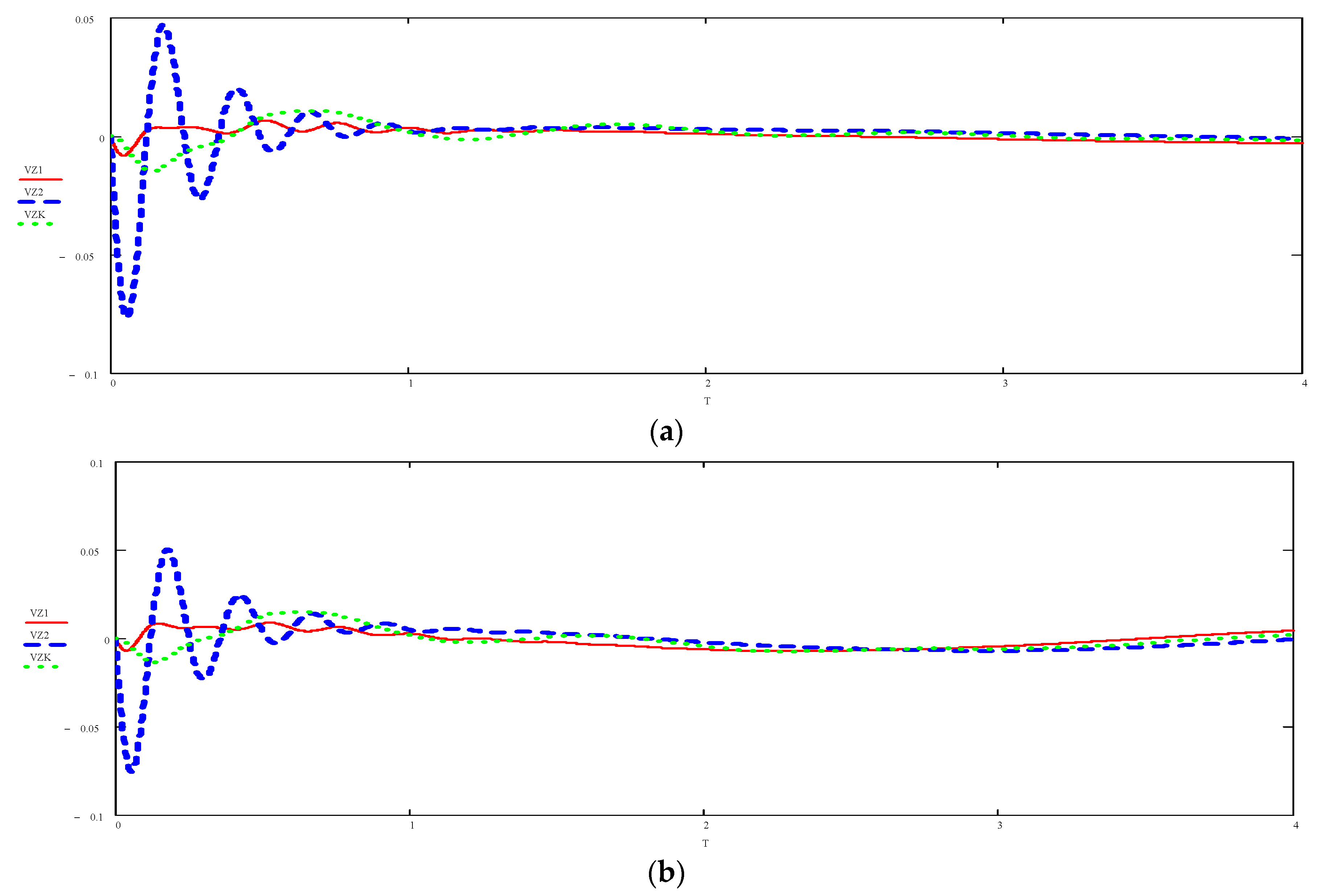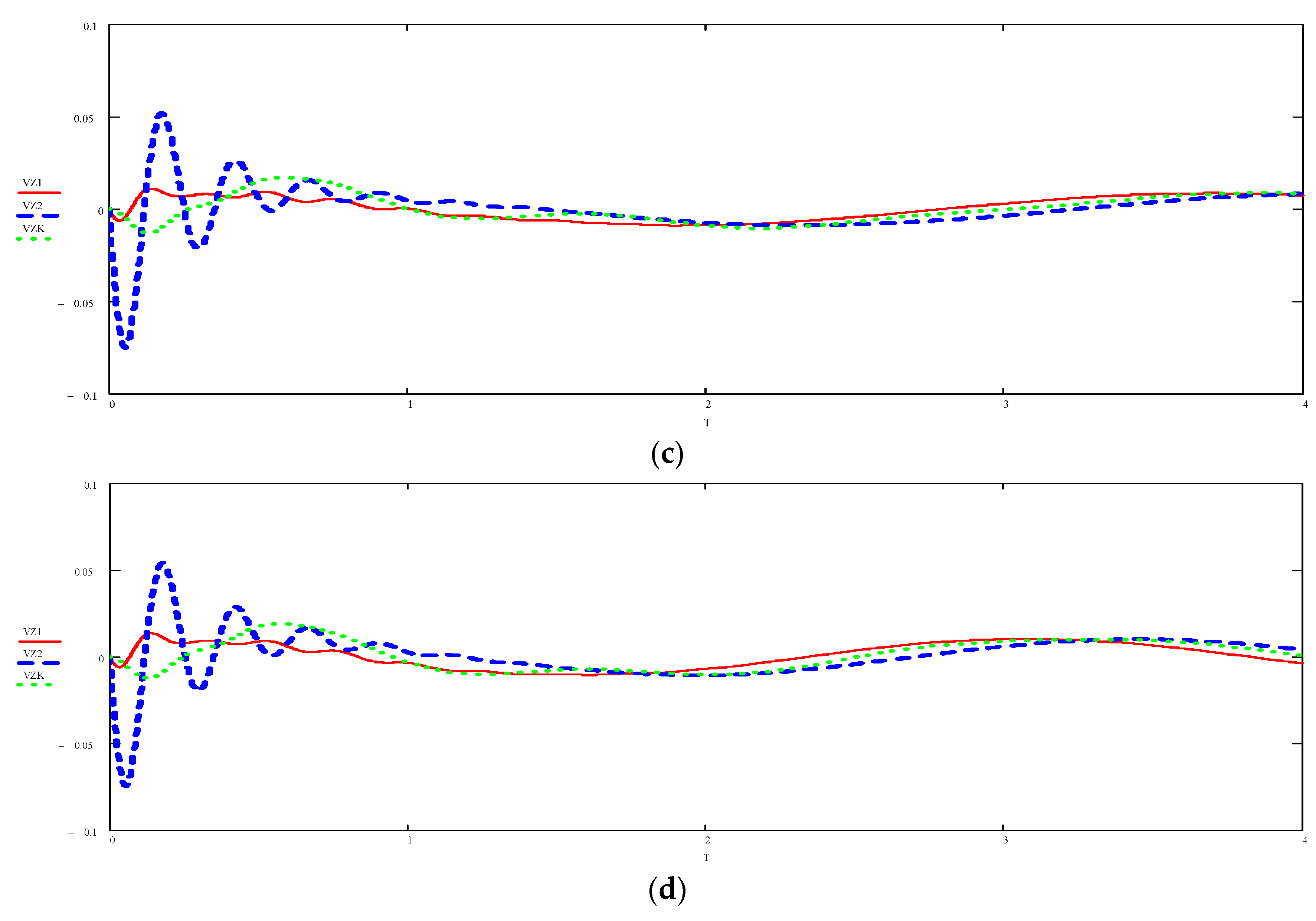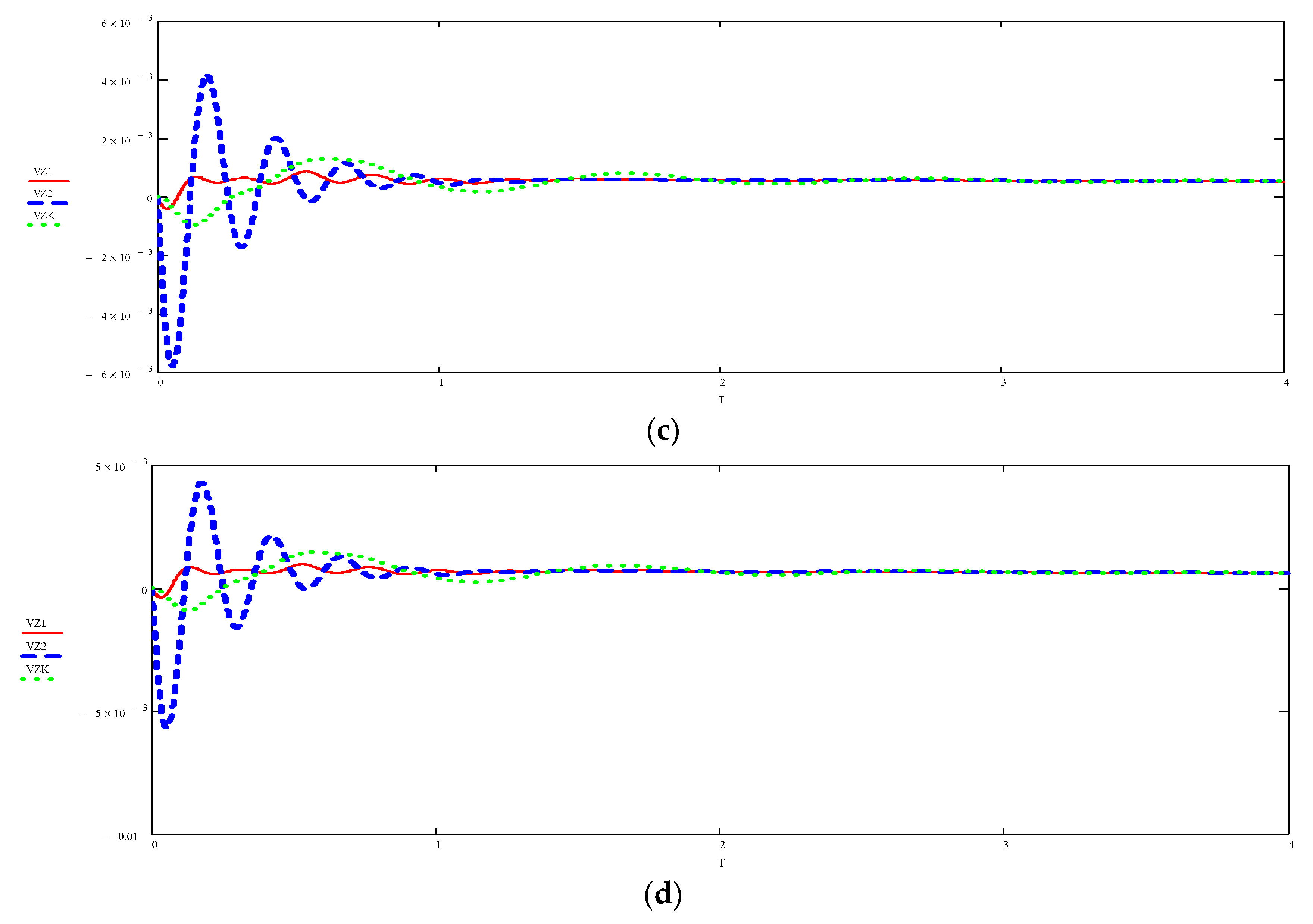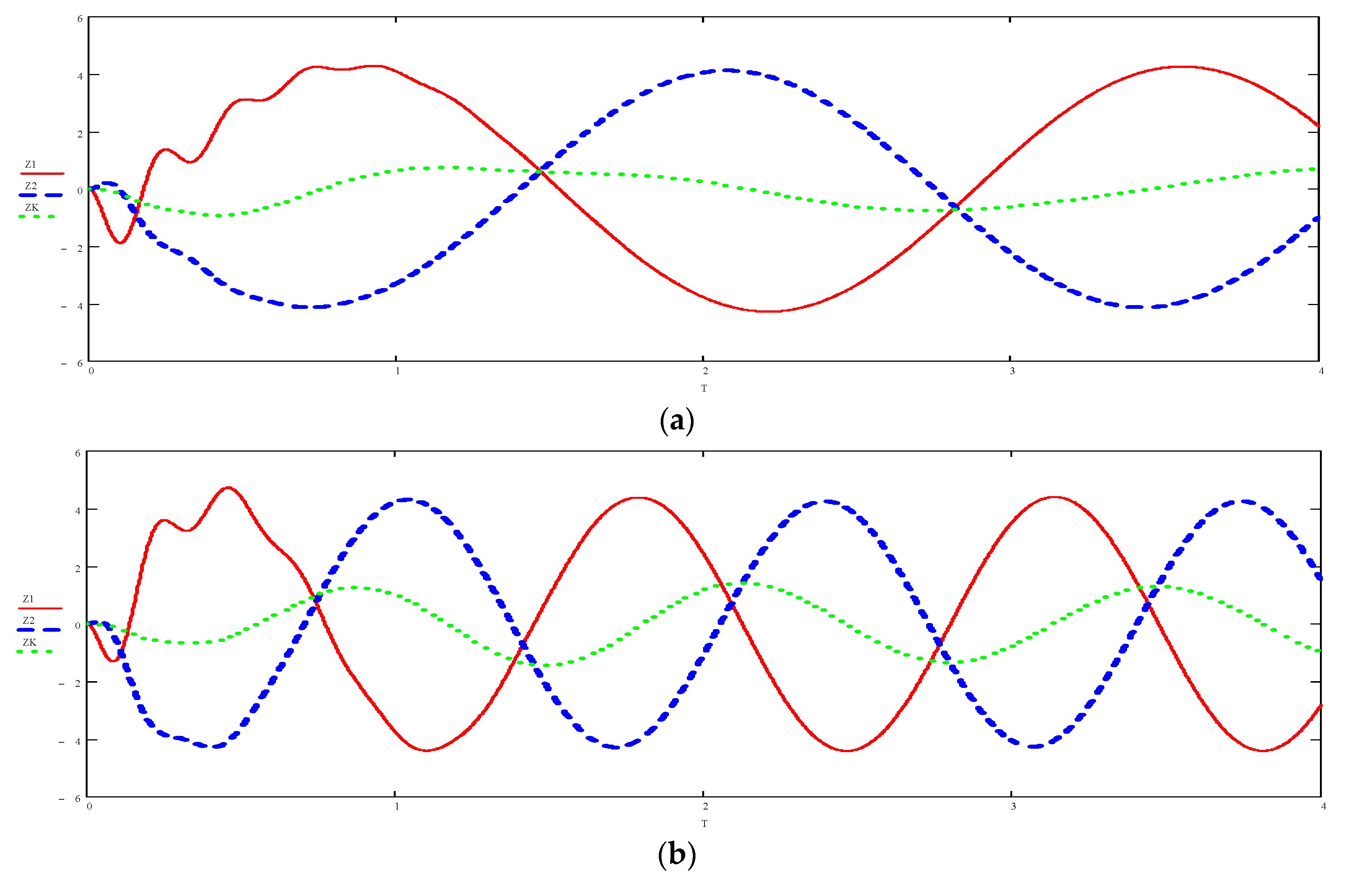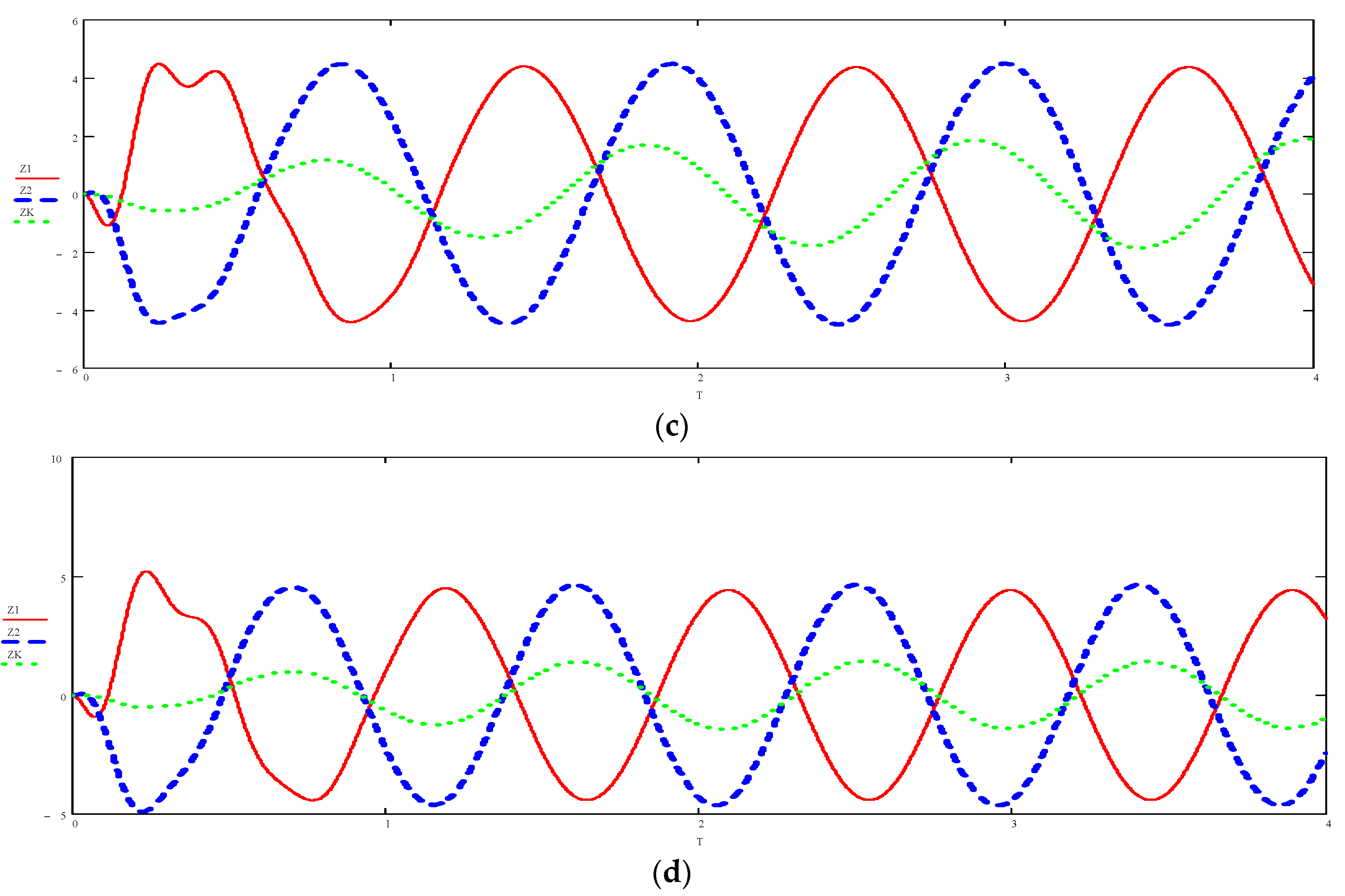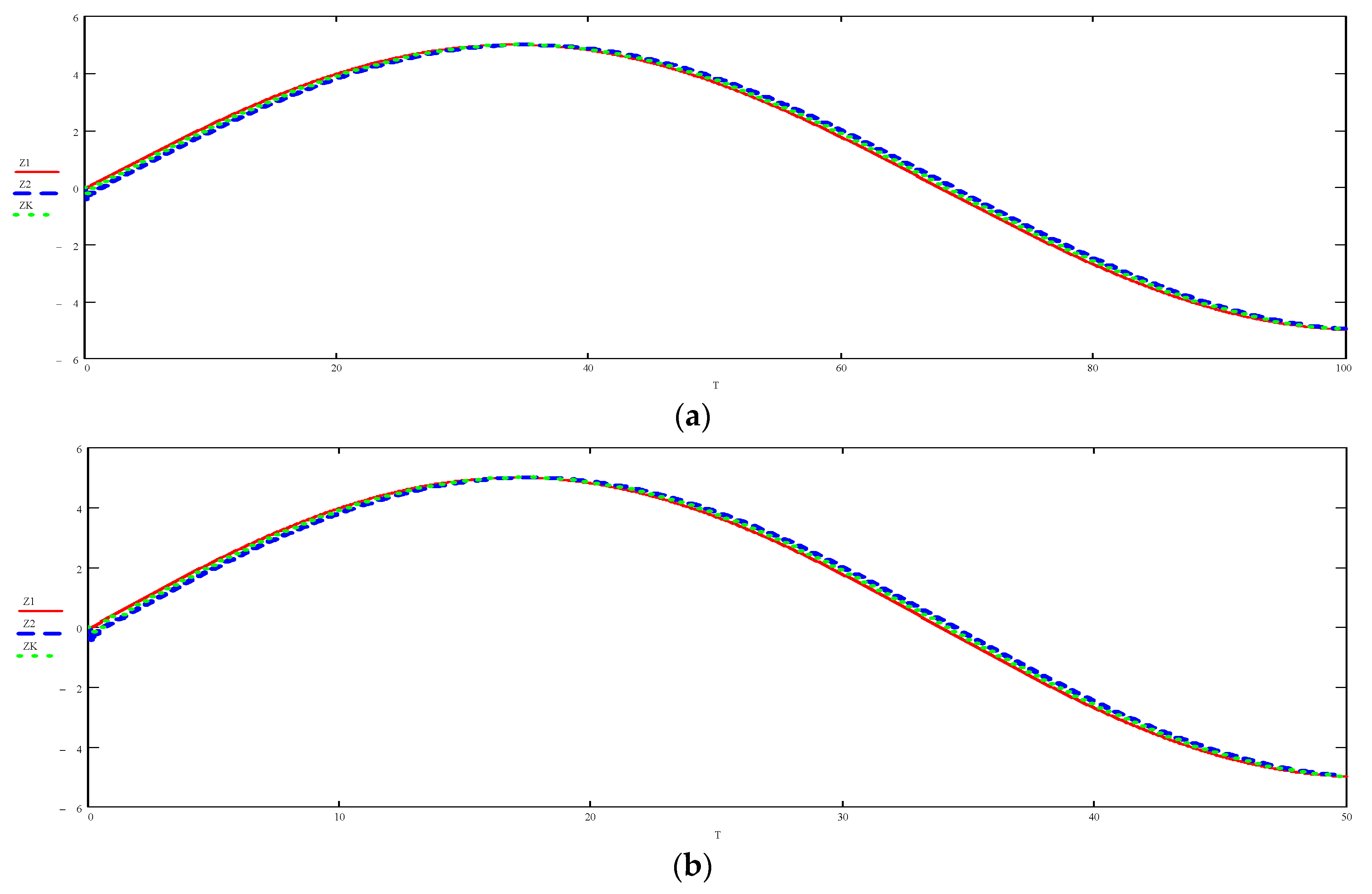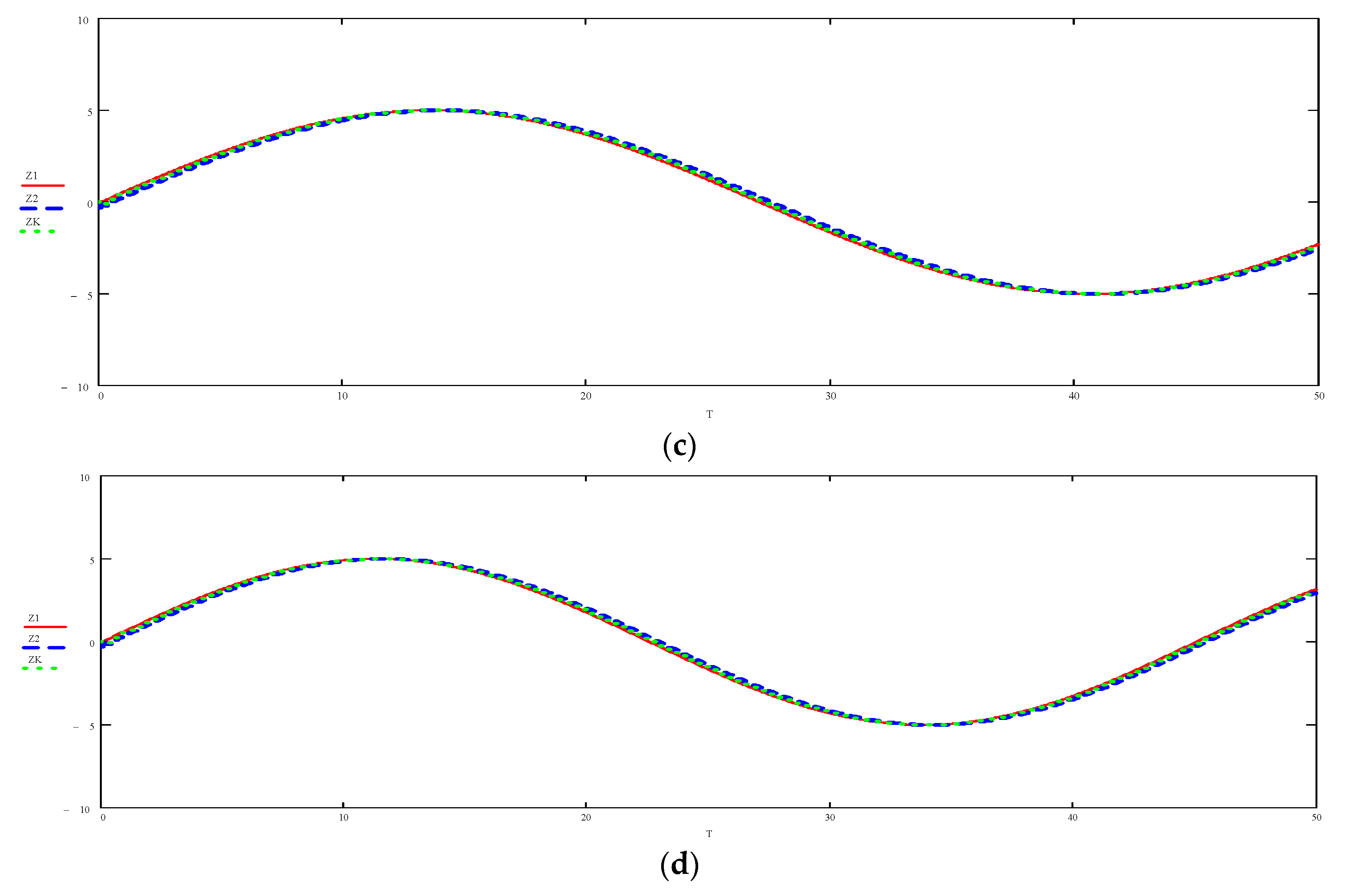2. Preparing the CKD6e shunting locomotive for testing
The preparation of the CKD6E shunting locomotive included the following steps:
- -
installation of load cells;
- -
installation of displacement sensors;
- -
installation of acceleration sensors [
9].
The location of the sensors on the locomotive is shown in
Figure 1.
Р1, Р3 – frame forces of the 1st and 3rd wheelset (transverse movements between the bogie frame and the wheelset);
TB1L, TB1R, TB3L, TB3R - vertical movements between the bogie frame and the axle box of the 1st and 3rd wheelset on the left and right sides;
KD II - coefficient of vertical dynamics of the second stage of spring suspension (strain diagram);
Y, Z - accelerations on the floor in the cabin in the transverse and vertical directions.
Installation of load cells consists of 5 stages:
Marking the places of installation of sensors;
Cleaning the places where the sensors are installed;
Installation of sensors;
Assembly of circuits and verification;
Circuit isolation.
When marking the location of the installation of sensors on the bogie of the locomotive, the places most prone to deformation during the movement of the locomotive are taken into account. The locations of the sensors were chosen empirically [
10]. The sensor installation sites are pre-cleaned with special equipment to a flat and smooth surface, and then the place is processed with sandpaper across the sensor installation to a slight roughness [
11]. This work must be done at all marked places for installing sensors (see
Figure 2).
Installation of sensors consists of the following steps:
- (a)
before installing the sensors on the cart, the sensor outputs are soldered to the blocks to prevent electrical contact with the surface of the cart;
- (b)
the installation site is treated (wiped) with acetone in order to degrease the surface. It is also necessary to wipe the glued (lower part) surface of the sensor with acetone;
- (c)
glue is applied to the sensor (second glue moment is universal);
- (d)
next, the sensor must be strongly pressed against the surface previously prepared for installation [
12]. It is important during the installation of the sensor to avoid the occurrence of air and bubbles between the sensor and the surface to be glued, it is necessary to press the sensor completely against the surface and hold for at least 30 seconds.
The dynamic performance of the diesel locomotive was measured simultaneously with measurements to determine the level of impact of the diesel locomotive on the track and turnouts [
13].
4. Dynamic performance of a diesel locomotive on a straight section of the track
Before testing, a track measuring car was passed through this section. Based on the results of the measurements, the maximum allowable speed was set at 90 km/h.
Figure 8.
Installation of strain gauges on the side neck of the rail.
Figure 8.
Installation of strain gauges on the side neck of the rail.
Figure 9.
Installation of load cells on the rail foot.
Figure 9.
Installation of load cells on the rail foot.
For the direct course of the diesel locomotive, the direction was taken when the CKD6E-2108 diesel locomotive moved forward with the 1st wheel pair [
20]. The coefficient of vertical dynamics of the first stage of the spring suspension was determined as the ratio of the dynamic vertical displacement of the bogie relative to the wheelset (axle box), registered during the movement of the diesel locomotive, to the vertical static deflection of the first stage, which is 123 mm for the CKD6e diesel locomotive [
21]. The coefficient of vertical dynamics of the second stage of the spring suspension was determined as the ratio of the values of the dynamic signal recorded by tensometric circuits to the value of the signal obtained during static tests.
Based on the results of data processing at a given speed, separate data arrays were formed for each sensor. According to these arrays, the estimated values of the coefficient of vertical dynamics of the first stage of the spring suspension were found [
22]. Dynamic vertical movements were processed without taking into account the quasi-static component. All measurements were divided into speeds and directions of movement. In each race, one maximum amplitude value of the dynamic process was selected.
Similarly, data processing was carried out to determine the coefficient of vertical dynamics of the second stage of the spring suspension. Frame forces were processed by the method described earlier.
Figure 10,
Figure 11 and
Figure 12 show oscillograms of primary measurements of dynamic processes recorded while driving along a straight section.
Figure 14 shows the graphs of the dependence of the coefficient of vertical dynamics of the first stage of the spring suspension on the speed when the diesel locomotive passes along a straight section of the track.
Figure 15 shows the graphs of the dependence of the coefficient of vertical dynamics of the second stage of the spring suspension on the speed when the diesel locomotive passes along a straight section of the track.
Figure 16 shows the graphs of the ratio of frame forces to the static load from the wheelset on the rails on the speed when the diesel locomotive passes along a straight section of the track.
The data of
Figure 13 and
Figure 14 show that the values of the coefficients of vertical dynamics of the first and second stages of the spring suspension of the CKD6E-2108 diesel locomotive do not exceed the permissible limits [
23]. The maximum values for the coefficients of vertical dynamics were 0.11 for the first stage and 0.25 for the second stage. It is worth noting that the limit value of 0.25 for the vertical dynamics coefficient of the second stage was obtained when driving at a speed of 90 km/h, i.e. 12.5% higher than design speed [
24].
The maximum value of the ratio of frame forces to the static load from the wheelset on the rails was 0.08.
Figure 16 shows the dependence of the stability factor against derailment of the wheel from the speed of movement, built on the basis of the results given in
Table 3. The minimum values of the stability factor against derailment calculated from the data recorded on the straight section of the track are shown in
Table 3.
As can be seen from
Figure 16 and
Table 3, the minimum value of the stability factor against wheel derailment on a straight section of the track is significantly higher than the standard value. Thus, the speed of movement along straight sections in accordance with the Norms of permissible movement speeds according to the assessment of dynamic indicators is limited by the design speed [
25].
6. Drawing up equations of vertical oscillations of a diesel locomotive
When compiling the mathematical model of oscillations of the undercarriage, a flat design scheme of the locomotive was adopted (see
Figure 24). Equations of steady-state spatial vertical oscillations of the vehicle-track system under study with respect to the complex amplitudes of generalized coordinates, compiled taking into account the accepted assumptions and describing forced oscillations in the longitudinal vertical plane [
29].
It is convenient to compose differential equations of oscillations of rail vehicles using the general equation of system dynamics [
1]:
where
- is the generalized force from active forces;
- is the generalized force of inertia; K - is the number of degrees of freedom of the system.
It is convenient to calculate the generalized inertial forces using the Lagrange operator, which in the problem of small oscillations is written as:
where
- kinetic energy of the system, depending only on generalized velocities.
The generalized forces from active forces can be found through the possible power of these forces according to the formula:
where the possible power of all given forces
corresponding to the generalized speed
through which the possible speeds
are expressed at each
i -th point of application of the force is equal to:
After substituting the values of the generalized inertial forces and the generalized active forces in (4) defined in the assumptions that
a system of linear differential equations of small oscillations is obtained relative to the position of a stable rectilinear uniform motion of the vehicle, in which the gravity forces of individual bodies and external active forces are balanced by static values bond reactions [
30]. The values of the generalized coordinates in this position are equal to zero. In translational motion, inertial forces act on the body, and in rotational motion, moments of inertia forces act on the body [
2]. Consequently, the equations of motion of the body in Cartesian coordinates will take the following form:
where
,
,
- is the force projections with number
i on the
x, y, z axes, respectively;
,
,
- is the projections of reactions of elastic (or elastoviscous) elements with number
j on the
x, y, z axes, respectively;
,
,
- is the moments of forces
Pi about axes
x, y, z;
,
,
- is the moments of force
about axes
;
,
,
- is the moments of inertia of a rigid body about the axes
;
,
,
- is the acceleration of the body along the axes
;
,
,
- is the angular accelerations of the body during its rotation around the axes
.
In Equations (5), the summation over i and j is performed algebraically, taking into account the sign of the force and the moment. To determine the sign of the force and moment, it is convenient to use the following rule: if the direction of the force or moment coincides with the direction of the forces of inertia or the moment of the forces of inertia, then when summed they are taken with a “plus”, if not, then with a “minus”.
The forces of inertia, according to Newton's second law, are equal to the mass times the acceleration, and are directed in the direction opposite to the acceleration [
1]. In our example, due to the arbitrary choice of the positive direction of coordinates, the positive acceleration is directed to the right, and the inertial force
- is the directed to the left. The same can be said about the direction of inertial forces
and moments of inertia forces
,
,
.
Reactions
on the design scheme are directed as if they acted with a positive deformation of elastic or elastic-viscous elements. For positive deformation, you can take either tension or compression at your discretion [
5]. In the diagram, the reactions are directed as if the named elements are experiencing compressive deformations.
Equations (5) are differential equations for the equilibrium of a body as it moves in a space defined by six coordinates. External forces are, as a rule, functions of time , and reactions - are functions of time, coordinates and their derivatives, i.e..
These equations are written for any small period of time during which it can be assumed that the inertia forces, external forces
and reactions
, are constants. To determine the trajectory of a body in a given space under the action of external forces, it is necessary to find the functions
, which, under given initial conditions, would turn the system of differential equations into an identity [
3,
4]. Along with the d'Alembert-Lagrange equations written in the Cartesian coordinate system, another form of notation is often used in mechanics - in the so-called generalized coordinate system. In this case, the variational equations of analytical mechanics are called the Lagrange equations of the second kind [
11].
The body and bogie of a diesel locomotive are solid bodies with two degrees of freedom and connected by elastic and dissipative bonds. Wheel pairs move without separation from the rails. Perturbations from the right and left rails will be taken the same, which allows us to consider plane oscillations [
6]. This formulation of the problem is quite sufficient to consider the main dynamic processes in the system [
7,
8,
9].
Model six degrees of freedom. To study oscillations in the vertical longitudinal plane, we will compose a system of six second-order differential equations describing oscillations in the vertical longitudinal plane. After the transformation, we obtain Equations (6)–(8).
Body oscillation equations:
The oscillation equations of the first bogie:
Equations of vibrations of the second cart:
The equations of bogie oscillations Equations (6) and (7) on the right side contain expressions describing the side of the track [
10].
The roughness of the path is an external perturbation of our system. The perturbation is fed to the inputs of the model with a displacement - the transport delay τ, determined by the geometric dimensions and the speed of movement:
The choice of the type of perturbing action from the path - the roughness of the path depends on the formulation of the problem and the accuracy required for the mathematical model [
16].
To analyze dynamic loads, it is necessary to obtain the acceleration values of the moving parts of the vehicle. Numerical integration subroutines used in the Mathcad package do not allow you to directly display the values of which derivatives [
22]. To do this, we use the derived equations (4). Substituting in them the parameters of the crew and the obtained values of the variables of the model, we obtain expressions for acceleration in the center of the body and in the driver's cab:
To determine the relative displacements in the hydraulic vibration dampers of the second tier, we use the following relations:
To solve the resulting system of differential equations by numerical methods on a computer, it is necessary to bring the resulting equations in the Cauchy form [
24]. To do this, we solve with respect to the second derivatives, and then we make a change of variables.
Initial data:
m1:=20; j1:=37; c1:=6100; a1:=1,85; b1:=20;
m2:=72; j2:=493; c2:=1500; a2:=6.85; b2:=100;
7. Results and Discussion
To display the results, new variables (vectors T, Z1, Z2, V1, V2), are introduced, which are assigned the value of the columns of the solution results matrix.
The results are presented in graphical form:
Figure 25 shows the graphs of the speed of movement of the body and bogies when moving along a short unevenness (L=30 mm) with different speeds [
15]. As can be seen in the figure, the first bogie at a speed of ϑ=40 km/h reaches a high oscillation amplitude of 0.05 m, and at a speed of ϑ=120 km/h the oscillation amplitude of 0.07 m.
Figure 26 shows the graphs of the speed of movement of the body and bogies when moving along a short unevenness (L=100 mm) at different speeds. As can be seen in the figure, with an uneven path with a length of 100 mm and a speed of ϑ=40 km/h, the oscillation amplitude reaches 0.017 m, and at a speed of ϑ=120 km/h it reaches 0.023 m.
Figure 27 shows the graphs of the speed of movement of the body and bogies when moving along a long unevenness (L=1500 mm) at different speeds [
24]. As can be seen in the figure, at a low speed ϑ=40 km/h and a long roughness of the track, the locomotive bogie reaches 0.0007 m amplitude, and at the maximum speed ϑ=120 km/h, the oscillations of the locomotive bogie reaches 0.001 m.
Based on the graphs obtained in
Figure 25,
Figure 26 and
Figure 27, we can conclude that with an increase in speed from 40 km/h to 120 km/h, the bogie oscillation amplitude changes (increases), which has a bad effect on the dynamics of the locomotive. On short bumps with the highest speed, the dynamics of the locomotive worsens [
26].
As can be seen in
Figure 28 for a short roughness (L=30 mm), the oscillation height reaches 5 mm. With an increase in speed, the frequency of amplitude oscillations increases, thereby deteriorating the smoothness of the movement of the locomotive.
In
Figure 29, the height of the amplitude also reaches 5 mm, and the oscillation frequency decreases by 2 times with a decrease in the speed of movement [
27,
28,
29,
30].
In
Figure 30, at speeds ϑ=40 km/h and ϑ=120 km/h, the height of the amplitude reaches 5 mm, and the oscillation frequency increases 3 times with increasing speed.
Based on the graphs obtained in
Figure 28,
Figure 29 and
Figure 30, it can be concluded that with a long roughness of the track, the amplitude of oscillations decreases significantly and the smoothness of the locomotive movement increases, which does not affect the dynamics of the locomotive.
Figure 1.
Placement of sensors for registration of processes to determine the dynamic performance of the type CKD6e-2108 diesel locomotive.
Figure 1.
Placement of sensors for registration of processes to determine the dynamic performance of the type CKD6e-2108 diesel locomotive.
Figure 2.
Installation of strain gauges on the side bearings of the locomotive bogie.
Figure 2.
Installation of strain gauges on the side bearings of the locomotive bogie.
Figure 3.
Vertical movements of the bogie frame relative to the wheelset of the locomotive CKD6E-2108 when moving along turnouts, mm.
Figure 3.
Vertical movements of the bogie frame relative to the wheelset of the locomotive CKD6E-2108 when moving along turnouts, mm.
Figure 4.
The ratio of frame forces to the static load from the wheelset on the rails on the CKD6E-2108 diesel locomotive when driving on turnout’s P65 grade 1/9 and 1/11 on the side.
Figure 4.
The ratio of frame forces to the static load from the wheelset on the rails on the CKD6E-2108 diesel locomotive when driving on turnout’s P65 grade 1/9 and 1/11 on the side.
Figure 5.
The ratio of frame forces to the static load from the wheelset on the rails on the CKD6E-2108 diesel locomotive when driving on turnout’s Р65 grades 1/9 and 1/11 in a straight line.
Figure 5.
The ratio of frame forces to the static load from the wheelset on the rails on the CKD6E-2108 diesel locomotive when driving on turnout’s Р65 grades 1/9 and 1/11 in a straight line.
Figure 6.
Stability factor against wheel derailment when passing a turnout with a 1/9 and 1/11 crosspiece on its side.
Figure 6.
Stability factor against wheel derailment when passing a turnout with a 1/9 and 1/11 crosspiece on its side.
Figure 7.
Stability factor against wheel derailment when passing a turnout with a crosspiece of brand 1/9 and 1/11 in a straight direction.
Figure 7.
Stability factor against wheel derailment when passing a turnout with a crosspiece of brand 1/9 and 1/11 in a straight direction.
Figure 10.
Vertical movements of the bogie frame relative to the wheelset of the CKD6E-2108 diesel locomotive when moving along a straight section of track, mm.
Figure 10.
Vertical movements of the bogie frame relative to the wheelset of the CKD6E-2108 diesel locomotive when moving along a straight section of track, mm.
Figure 11.
The coefficient of vertical dynamics of the second stage of the spring suspension of the CKD6E-2108 diesel locomotive when moving along a straight section of the track.
Figure 11.
The coefficient of vertical dynamics of the second stage of the spring suspension of the CKD6E-2108 diesel locomotive when moving along a straight section of the track.
Figure 12.
Frame forces on a CKD6E-2108 diesel locomotive when moving along a straight section of track.
Figure 12.
Frame forces on a CKD6E-2108 diesel locomotive when moving along a straight section of track.
Figure 13.
Coefficient of vertical dynamics of the first stage of the spring suspension of the CKD6E-2108 diesel locomotive when moving along a straight section of the track.
Figure 13.
Coefficient of vertical dynamics of the first stage of the spring suspension of the CKD6E-2108 diesel locomotive when moving along a straight section of the track.
Figure 14.
The coefficient of vertical dynamics of the second stage of the spring suspension of the CKD6E-2108 diesel locomotive when moving along a straight section of the track.
Figure 14.
The coefficient of vertical dynamics of the second stage of the spring suspension of the CKD6E-2108 diesel locomotive when moving along a straight section of the track.
Figure 15.
The ratio of frame forces to the static load from the wheelset on the rails on the CKD6E-2108 diesel locomotive when moving along a straight section of track.
Figure 15.
The ratio of frame forces to the static load from the wheelset on the rails on the CKD6E-2108 diesel locomotive when moving along a straight section of track.
Figure 16.
Stability factor against wheel derailment on a straight section of the track.
Figure 16.
Stability factor against wheel derailment on a straight section of the track.
Figure 17.
Vertical movements of the bogie frame relative to the wheelset of the CKD6E-2108 diesel locomotive when moving in a curve with a radius of 400 m.
Figure 17.
Vertical movements of the bogie frame relative to the wheelset of the CKD6E-2108 diesel locomotive when moving in a curve with a radius of 400 m.
Figure 18.
The coefficient of vertical dynamics of the second stage of the spring suspension of the CKD6E-2108 diesel locomotive when moving in a curve with a radius of 400 m.
Figure 18.
The coefficient of vertical dynamics of the second stage of the spring suspension of the CKD6E-2108 diesel locomotive when moving in a curve with a radius of 400 m.
Figure 19.
Frame forces on a CKD6E-2108 diesel locomotive when moving in a curve with a radius of 400 m.
Figure 19.
Frame forces on a CKD6E-2108 diesel locomotive when moving in a curve with a radius of 400 m.
Figure 20.
The coefficient of vertical dynamics of the first stage of the spring suspension of the CKD6E-2108 diesel locomotive when moving in a curve with a radius of 400 m.
Figure 20.
The coefficient of vertical dynamics of the first stage of the spring suspension of the CKD6E-2108 diesel locomotive when moving in a curve with a radius of 400 m.
Figure 21.
The coefficient of vertical dynamics of the second stage of the spring suspension of the CKD6E-2108 diesel locomotive when moving in a curve with a radius of 400 m.
Figure 21.
The coefficient of vertical dynamics of the second stage of the spring suspension of the CKD6E-2108 diesel locomotive when moving in a curve with a radius of 400 m.
Figure 22.
The ratio of frame forces to the static load from the wheelset on the rails on the CKD6E-2108 diesel locomotive when moving in a curve with a radius of 400 m.
Figure 22.
The ratio of frame forces to the static load from the wheelset on the rails on the CKD6E-2108 diesel locomotive when moving in a curve with a radius of 400 m.
Figure 23.
Safety factor against wheel derailment in a curve with a radius of 400 m.
Figure 23.
Safety factor against wheel derailment in a curve with a radius of 400 m.
Figure 24.
Kinematic diagram of a diesel locomotive model.
Figure 24.
Kinematic diagram of a diesel locomotive model.
Figure 25.
Graph of the speed of movement of the body and bogies when moving along a short unevenness (L=30 mm) with different speeds: a) ϑ=40 km/h; b) ϑ=80 km/h; c) ϑ=100 km/h; d) ϑ=120 km/h.
Figure 25.
Graph of the speed of movement of the body and bogies when moving along a short unevenness (L=30 mm) with different speeds: a) ϑ=40 km/h; b) ϑ=80 km/h; c) ϑ=100 km/h; d) ϑ=120 km/h.
Figure 26.
Graph of the speed of movement of the body and bogies when moving along a short unevenness (L=100 mm) with different speeds: a) ϑ=40 km/h; b) ϑ=80 km/h; c) ϑ=100 km/h; d) ϑ=120 km/h.
Figure 26.
Graph of the speed of movement of the body and bogies when moving along a short unevenness (L=100 mm) with different speeds: a) ϑ=40 km/h; b) ϑ=80 km/h; c) ϑ=100 km/h; d) ϑ=120 km/h.
Figure 27.
Graph of the speed of movement of the body and bogies when moving along a long unevenness (L=1500 mm) with different speeds: a) ϑ=40 km/h; b) ϑ=80 km/h; c) ϑ=100 km/h; d) ϑ=120 km/h.
Figure 27.
Graph of the speed of movement of the body and bogies when moving along a long unevenness (L=1500 mm) with different speeds: a) ϑ=40 km/h; b) ϑ=80 km/h; c) ϑ=100 km/h; d) ϑ=120 km/h.
Figure 28.
Graph of the movement of the body and bogies when moving along a short unevenness (L=30 mm) with different speeds: a) ϑ=40 km/h; b) ϑ=80 km/h; c) ϑ=100 km/h; d) ϑ=120 km/h.
Figure 28.
Graph of the movement of the body and bogies when moving along a short unevenness (L=30 mm) with different speeds: a) ϑ=40 km/h; b) ϑ=80 km/h; c) ϑ=100 km/h; d) ϑ=120 km/h.
Figure 29.
Graph of the movement of the body and bogies when moving along a short unevenness (L=100 mm) with different speeds: a) ϑ=40 km/h; b) ϑ=80 km/h; c) ϑ=100 km/h; d) ϑ=120 km/h.
Figure 29.
Graph of the movement of the body and bogies when moving along a short unevenness (L=100 mm) with different speeds: a) ϑ=40 km/h; b) ϑ=80 km/h; c) ϑ=100 km/h; d) ϑ=120 km/h.
Figure 30.
Graph of the movement of the body and bogies when moving along the length of the unevenness (L=1500 mm) with different speeds: a) ϑ=40 km/h; b) ϑ=80 km/h; c) ϑ=100 km/h; d) ϑ=120 km/h.
Figure 30.
Graph of the movement of the body and bogies when moving along the length of the unevenness (L=1500 mm) with different speeds: a) ϑ=40 km/h; b) ϑ=80 km/h; c) ϑ=100 km/h; d) ϑ=120 km/h.
Table 1.
Stability factor against wheel derailment in turnouts with a 1/9 cross.
Table 1.
Stability factor against wheel derailment in turnouts with a 1/9 cross.
| Direction of travel |
Minimum KZU value |
| sideways movement |
straight line |
| speed, km/h |
|---|
| |
15 |
25 |
40 |
50 |
60 |
80 |
90 |
| forward |
2,49 |
2,47 |
2,43 |
2,24 |
2,83 |
2,73 |
2,71 |
| Reverse |
2,51 |
2,72 |
2,59 |
2,27 |
2,61 |
2,70 |
2,59 |
| Allowed value |
1,4 |
Table 2.
Stability factor against wheel derailment in turnouts with a crosspiece of brand 1/11.
Table 2.
Stability factor against wheel derailment in turnouts with a crosspiece of brand 1/11.
| Direction of travel |
Minimum KZU value |
| sideways movement |
straight line |
| speed, km/h |
| |
15 |
25 |
40 |
50 |
60 |
80 |
90 |
| forward |
2,86 |
2,68 |
2,78 |
2,45 |
2,85 |
2,68 |
2,60 |
| Reverse |
2,76 |
2,59 |
2,59 |
2,52 |
2,75 |
2,49 |
2,36 |
| Allowed value |
1,4 |
Table 3.
Stability factor against wheel derailment on a straight section of the track.
Table 3.
Stability factor against wheel derailment on a straight section of the track.
| Direction of travel |
Minimum value of KZU, at speed, km/h |
| 50 |
70 |
80 |
90 |
| forward stroke |
3,31 |
3,39 |
3,25 |
3,04 |
| Reverse stroke |
3,06 |
2,76 |
2,90 |
2,84 |
| Allowed value |
1,4 |
Table 4.
Stability factor against wheel derailment when moving in a curve with a radius of 400 m.
Table 4.
Stability factor against wheel derailment when moving in a curve with a radius of 400 m.
| Minimum value of KZU, at speed, km/h |
|---|
| Direction of travel |
25 |
40 |
60 |
85 |
| forward stroke |
3,20 |
3,28 |
3,48 |
3,12 |
| reverse stroke |
3,05 |
3,11 |
3,04 |
3,05 |
| Allowed value |
1,4 |

